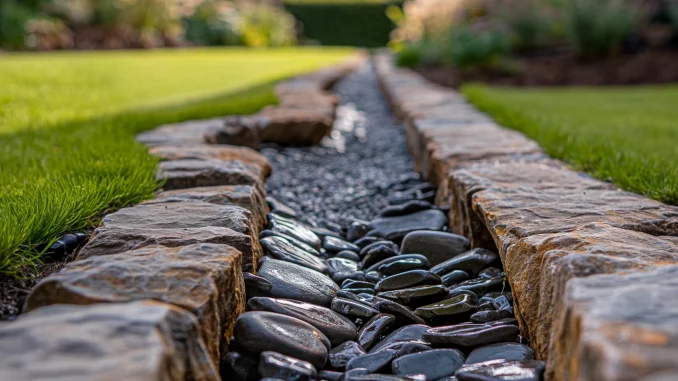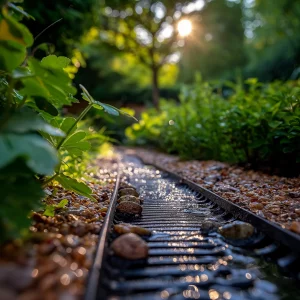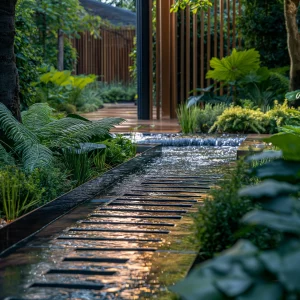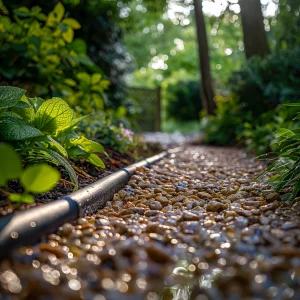
The Importance of Effective Garden Drainage
Effective garden drainage is essential, especially in the UK, where unpredictable weather can lead to excessive moisture in gardens. This excess moisture can cause waterlogging, which deprives plant roots of necessary oxygen. This can lead to diseases like root rot and promote the growth of fungi and pests. These issues can significantly impair plant health, soil integrity, and the landscape’s aesthetic.
Waterlogged soil tends to become compacted over time, losing its structure and fertility, diminishing its ability to support plant life and complicating effective drainage. Addressing these drainage issues is not just about plant health—it’s about maintaining your property’s overall value and enjoyment. Implementing budget-friendly drainage solutions, such as simple DIY tests to assess soil conditions, using locally available materials for soil improvement, and choosing appropriate plants that manage moisture well, can significantly mitigate these problems.
By recognising and tackling these issues early, homeowners can ensure their garden survives and thrive. This proactive approach saves considerable time and resources, emphasising that a well-planned, budget-friendly drainage system is not just a functional necessity but a wise investment in your garden’s long-term health and beauty.
Evaluating Soil Conditions

Before implementing any drainage solutions, it’s essential to evaluate the existing soil conditions in your garden. One effective method to assess soil moisture levels is the 24-hour water drainage test. This simple test involves digging a hole about a foot in depth and width, filling it with water, and observing how long it takes to drain completely. If the water takes longer than 24 hours to drain, the soil has poor drainage and will likely require some intervention to improve its condition.
In addition to the drainage test, examining the soil’s texture and composition is crucial. Soil types vary widely, from sandy and loose to heavy and clay-rich. Each type handles moisture differently, necessitating different strategies for effective water management. For instance, clay soils are particularly prone to waterlogging because their dense structure impedes water flow.
Understanding your soil type will guide the selection of appropriate amendments and interventions to enhance its drainage capabilities. This knowledge helps choose the right solutions and prevents unnecessary expenditure on unsuitable or ineffective drainage enhancements.
Cost-Effective Solutions
Once you’ve established the need for improved drainage and understand your soil’s characteristics, you can implement cost-effective solutions tailored to your garden’s requirements.
Plant Choices: Selecting the right plants can significantly influence your garden’s water management. Consider planting species that thrive in moist conditions for areas prone to wetness. Water-tolerant plants, such as hydrangeas and willows, can absorb excess moisture and help stabilise the soil. Alternatively, moisture-tolerant grasses and groundcovers can provide coverage and help reduce surface runoff.
Soil Improvements: Organic matter such as compost can improve the soil’s texture and drainage capacity, enhancing soil structure and promoting healthy root growth. Adding coarse grit or sand can improve porosity and water flow for particularly heavy soils. These amendments help create an environment where water drains more freely, reducing the likelihood of waterlogging.
Physical Modifications: Simple physical modifications can also effectively manage water in your garden. Techniques such as aeration, which involves pricking or spiking the soil, allow air and water to penetrate more deeply and improve root growth. Constructing raised beds is another practical approach, especially in areas with poor drainage. Raised beds elevate the root zone above wet soils, significantly reducing the risk of waterlogging. Additionally, mulches like bark chippings can help regulate soil moisture and protect against extreme wetness.
Drainage Systems: More structured solutions may be necessary for gardens with severe drainage issues. Installing drainage systems such as French drains, dry wells, or simple ditches can be highly effective. These systems work by redirecting excess water away from critical areas, protecting plant roots from saturation and preventing the accumulation of surface water. While installation might seem daunting, many of these systems are surprisingly straightforward and can be constructed with minimal technical skill and budget.
Adhering to Regulations

One critical step in implementing garden drainage solutions involves understanding and adhering to local regulations. Land and water management regulations can vary significantly by region, and non-compliance can lead to fines and other legal complications. Before initiating any significant modifications to your garden’s drainage system, it’s essential to consult with local planning authorities.
These regulations often cover aspects such as redirecting water to public drainage systems, impacting your drainage on neighbouring properties, and the environmental effects of any interventions you plan to undertake. For example, certain areas may restrict or regulate the installation of impermeable surfaces, such as concrete, which can increase surface runoff and affect municipal drainage systems. Understanding these guidelines ensures that your drainage improvements are legally sound and environmentally responsible.
Permits and Professional Guidance: Specific drainage solutions may sometimes require a permit. For instance, the installation of large-scale drainage systems or alterations that significantly change the landscape or water flow might need official approval. Consulting professionals, such as landscape architects or civil engineers, can provide valuable advice on complex drainage problems and regulatory compliance. They can also help design systems that are effective and in line with local environmental conservation efforts, thereby streamlining the permit process.
Routine Maintenance and Professional Consultation
Once your drainage systems are in place, routine maintenance becomes vital to their longevity and effectiveness. Regular checks and upkeep prevent blockages from debris, such as leaves and silt, which can compromise the system’s efficiency.
Maintenance Practices:
- Inspect and Clean: Regularly inspect your drainage solutions, such as French drains and ditches, to ensure they are blockage-free and in good working condition.
- Monitor Plant Growth: Keep an eye on plant growth around drainage areas. Overgrown vegetation can obstruct water flow and reduce the efficiency of drainage systems.
- Check for Erosion: Erosion can subtly alter the landscape, potentially impacting the effectiveness of your drainage solutions. Periodic checks can help you identify and address erosion issues before they require costly repairs.
Consulting Professionals: Consulting with a professional can be invaluable for homeowners facing complex drainage issues or needing to ensure regulatory compliance. Hydrology or landscape design specialists can offer customized solutions that consider your property’s unique aspects. Furthermore, they can assist in addressing any legal stipulations associated with water management in your area, providing peace of mind and ensuring that your drainage system remains effective and compliant over time.
“A professional drainage contractor brings expertise and precision to the table, ensuring that your garden’s drainage system is effectively installed and compliant with local regulations. While DIY solutions can be cost-effective, complex drainage issues often require professional assessment to prevent long-term damage and ensure optimal functionality. Hiring a professional can save you time, money, and the hassle of dealing with unforeseen complications,” Mark Cordner, 24/7 Drainage UK.
Sustainable Approaches

Incorporating sustainable and aesthetic elements into your garden’s drainage solutions enhances functionality and boosts your landscape’s overall appeal. Creative approaches such as rain gardens and dry creek beds serve dual purposes by managing runoff and adding visual interest.
Sustainable Features:
- Rain Gardens: These are shallow depressions planted with native shrubs, perennials, and flowers, designed to collect and filter runoff from rooftops, driveways, and other impervious surfaces. Rain gardens effectively reduce the burden on traditional drainage systems and enhance local biodiversity.
- Dry Creek Beds: These features mimic the natural appearance of a dry riverbed and can be both a focal point in your garden and a practical solution for directing excess water during heavy rains.
Rainwater Harvesting: Using rain barrels or installing more complex rainwater harvesting systems can significantly reduce your garden’s drainage load. By collecting rainwater from roofs and storing it for future use, you manage excess water efficiently and conserve water. This harvested rainwater can be used for irrigation, reducing reliance on municipal water systems and lowering water bills.
Building Sustainable Drainage Systems (SuDS): SuDS are designed to manage rainfall in a way that mimics natural processes, using solutions that permeate, detain, and evaporate water. These systems aim to manage water runoff at the source and minimise environmental impact. Examples of SuDS include permeable pavements, green roofs, and swales—all designed to slow down water flow and enhance natural absorption. By implementing these systems, you handle excess water effectively, support local wildlife, and improve the quality of water entering local watercourses.
Final Thoughts
In conclusion, mastering garden drainage on a budget requires a blend of understanding, innovation, and adherence to local environmental standards. By assessing soil conditions, implementing sustainable drainage solutions, and engaging in routine maintenance, homeowners can significantly enhance the health and aesthetics of their gardens.
Moreover, community involvement and staying abreast of new technologies are pivotal in advancing sustainable practices. Embracing these principles ensures a thriving garden and contributes to broader environmental health and resilience, making it a worthwhile endeavour for any gardener looking to make a positive impact.